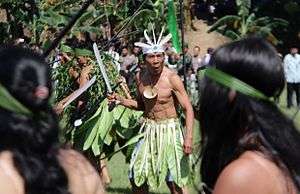Enggano people
 An Enggano man performing a war dance. | |
| Total population | |
|---|---|
| 1,500 (2000)[1] | |
| Regions with significant populations | |
|
| |
| Languages | |
| Enggano language, Indonesian language | |
| Religion | |
| Christianity (Roman Catholicism), Islam (Sunni), Folk religion (animism, totemism, ancestral worship) | |
| Related ethnic groups | |
| Batak, Nias people |
Enggano people are an isolated group of people in Indonesia that inhabits Enggano Island near the southwest off the coast of Sumatra Island. The population of the people are numbered at approximately 1,000 people as of 1999 and is constantly decreasing.[2]
Language
The Enggano language that the people spoke are an early Northwest Sumatran languages of the Austronesian languages.[2]
Origin and social structure

The Enggano people are one of the oldest tribes of Sumatra. They were first discovered by Portuguese explorers in the early 1500s and the Enggano people referred to themselves as E Lopeh people.[3] Ethnically, they are closely related to the indigenous tribes of Java and Sumatra, from where migration flows directly to Enggano Island.[4] The most anthropologically related people of the Enggano people are the Batak and Nias people and distantly related to the Lampung people (Abung and Pepaduan).[5]
The social organization of the Enggano people largely resembles the social model of the Nias people and now retains the paternal features of the family. Rural communities are of a neighbor-large-family type. The main social unit is marga or merga (surname), an expanded genus whose members are descended from a common male ancestor and retain its name, usually legendary. Outsiders from other margas that came later also live in the settlement. Within the marga there are also saompu, large patriarchal families, where each of them occupies one house. A large family has land and is governed by its elder. Communities are governed by elective village councils.[5]
It is thought that they strictly observe matrilineal exogamous traditions, where men and children of the village belong to the marga of their forefathers, while wives are taken from other marga. One cannot marry into the same marga or to a woman from the marga from which the groom's sister marries. But this is not exactly the case, as Enggano couples from the same clan are still allowed to married, provided they are of a different sub-clan.[6] The core family unit in Enggano society is based on the monogamy marriage, as polygamy is strictly forbidden.[7] Marriage settlement is patrilocal. A married woman passes into the family of her husband, takes on his surname, preserving it as her family name. The groom's father allocates a piece of land to his son, the child that receives the family name of his father.[5]
Modern political orientation

Today, the Enggano people; due to prolonged cultural isolation, is on the verge of extinction. They are alien to the neighboring peoples, for example, unlike the Batak people in recent decades, the appearance and growth of ethnic self-awareness are prevalent, especially among the mainstream Indonesians.[8]
Religion
Among the Enggano people, approximately equal of the population professes Islam (mainly Sunni) and Christianity (mainly Catholicism). Apart from that, there are places where animism,[9] totemism and ancestral worship are still being preserved.[2]
Traditional settlement
Enggano settlements are structurally cumulus. Their houses have stilt frames, stacked and rectangular in shape (whereas the past, they were rounded), with the walls and roof are strengthened by rigid leaves.[2]
Lifestyle
Enggano people engaged in manual farming (maize, yam, peanuts, taro, coconut palm), hunting for turtles, breeding of chickens and fishing. Handicrafts works are such as weaving, pottery, woodcarving, making of masks and necklaces, weaving mats and ornaments from beads.[2] Wood carvings by the Enggano people have a very strange resemblance to those in Polynesia.[10]
Enggano men wear kain loincloths of various lengths, and the length of the kain in direct proportion testifies to the economic status of its wearer. Enggano women always wear long kain. Men's outer garment is a shirt with long sleeves and a blind collar, while women have a shirt without a collar.[5]
Enggano food is mainly vegetable, and rice is usually bought.[2]
See also
References
- ↑ "Enggano". Ethnologue. Retrieved 2018-01-08.
- 1 2 3 4 5 6 В.А Тишков, ed. (1998). "Научное издательство "Большая российская энциклопедия". Народы и религии мира: энциклопедия. Большая Российская Энциклопедия. p. 653.
- ↑ Thomas Koten, ed. (5 December 2017). "Kisah Sepasang Manusia yang Melahirkan Suku Enggano di Ujung Barat Sumatera". Netral News. Retrieved 2018-06-11.
- ↑ Reimar Schefold, P. Nas & Gaudenz Domenig, ed. (2008). Indonesian Houses, Volume 2. Singapore University Press. p. 468. ISBN 90-671-8305-9.
- 1 2 3 4 А.А. Губера, ed. (1966). Народы Юго-Восточной Азии: этнографические очерки. АН СССР, Ин-т этнографии им. Н.Н. Миклухо-Маклая. p. 531-534.
- ↑ Pieter ter Keurs (2006). Condensed Reality: A Study of Material Culture ; Case Studies from Siassi (Papua New Guinea) and Enggano (Indonesia). Amsterdam University Press. p. 186. ISBN 90-578-9112-3.
- ↑ Koentjaraningrat & V. Simorangkir (1993). "Departemen Sosial dan Dewan Nasional Indonesia Untuk Kesejahteraan Sosial". Masyarakat terasing di Indonesia. Penerbit PT Gramedia Pustaka Utama. p. 86. ISBN 97-951-1676-2.
- ↑ Н. А Симония & Людмила Федоровна Пахомова (1983). "Институт востоковедения (Академия наук СССР)". Индонезия, справочник. Изд-во "Наука," Глав. ред. восточной лит-ры. p. 17-31.
- ↑ James Louis Garvin, Franklin Henry Hooper & Warren Earle Cox, ed. (1929). The Encyclopedia Britannica, Volume 21. Encyclopedia Britannica Company, Limited. p. 550.
- ↑ Nias: tribal treasures: cosmic reflections in stone, wood, and gold. Volkenkundig Museum Nusantara. 1990. p. 23. ISBN 90-714-2305-0.